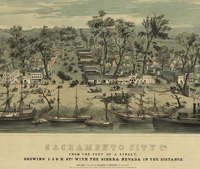February 19, 2010 --The partners from the Model Technological and Social Architecture for the Preservation of State Government Digital Information Project convened on January 20, 2010 in Sacramento, California (external link).

State partners are preserving digital legislative information. (Image Credit: Library of Congress Prints and Photographs Division).
The project, lead by the Minnesota Historical Society, is working with legislatures in several states to explore enhanced access to legislative digital records. The purpose of this meeting was to provide an update on recent activities, concentrating on a demonstration of the open source eXist native XML database (external link).
eXist has been selected by the project for building pilot applications for importing, searching, exporting and managing digital legislative information, much of which is already in XML format. In conjunction with the meeting, the project has published a white paper (external link) on XML Native Databases, providing background information on how XML has changed the way data can be stored and accessed, and providing a primer on the differences between the different types of XML databases.
Bob Horton opened the meeting with updates for the attendees. He discussed the project outcomes, which are to test a model in Minnesota to capture, preserve and provide access to “at-risk” digital content from the state legislature. Minnesota is sharing their experience with the other partners, with each state providing input on the process and determining its capacity to adapt the model. The results are being regularly promoted through education and outreach while the project works to connect its activities to national cyberinfrastructure activities.
Carol Kussmann of the MHS gave a presentation on eXist, demonstrating applications that have been developed for the project. Isaac Holmlund of the Minnesota Office of the Revisor of Statutes (external link) (the legislative office that provides nonpartisan services to members of both houses of the Minnesota legislature as well as all constitutional offices, state agencies and departments) also spoke about eXist production workflow.
During the meeting, the project filmed participants talking about the project or digital preservation in general. These video clips will be used to create future project videos similar to their first (external link), which featured Margaret Anderson Kelliher, the Speaker of the Minnesota House of Representatives.
Future work for the project includes more work with the XML wrapper for digital legislative information (with a model schema to be released soon); the creation of additional eXist applications that work across organizational boundaries; and a gap analysis on what has been learned so far, including guiding principles on how the state partners can take the current work and adapt it to their environment.
